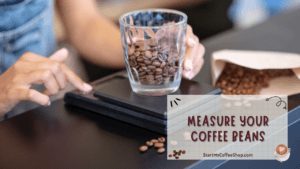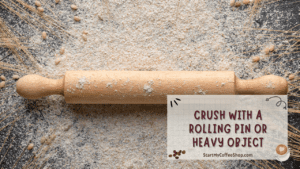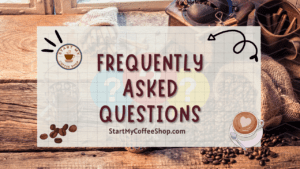Coffee lovers are aware that freshly ground beans are necessary for a delicious brew. Even while having a coffee grinder at home is the most practical way to do this, there are times when you can find yourself without it.
To grind coffee without a grinder, you should place the beans in a plastic bag and crush them with a rolling pin or a heavy object. Alternatively, use a blender or food processor to achieve a coarse consistency. Be careful not to over-grind and create a powdery texture.
Plastic Bag and Rolling Pin
The process of grinding coffee beans without the use of a grinder can be accomplished through the use of a straightforward method that requires only a plastic bag, a rolling pin, or another heavy object. This method is perfect for coffee enthusiasts who find themselves in a situation where they do not have access to a grinder, such as when they are traveling, camping, or staying in a location that does not have equipment for brewing coffee.
If you put the coffee beans in a robust plastic bag with a resealable top and gently crush them with a rolling pin or another heavy instrument, you can achieve a coarse consistency that will result in a cup of coffee that is consistently flavorful and delightful to drink.
Measure Your Coffee Beans

Start by accurately measuring the quantity of coffee beans you wish to grind before beginning the process of grinding coffee without a grinder. This step is essential because it guarantees that you keep the right coffee-to-water ratio, which has an immediate impact on the flavor and strength of your brew.
A conventional coffee scoop, which can typically handle two tablespoons of whole coffee beans, is advised for best results. This amount makes enough to brew about one cup of coffee. You may, however, change the measurement to suit your tastes and the number of cups you plan to brew.
For various brewing techniques like pour-over, French press, or cold brew, it’s crucial to measure the coffee beans precisely. To extract the greatest characteristics from the beans and make a good cup of coffee, each process requires particular ratios.
A precise coffee-to-water ratio when employing the pour-over method enables a balanced extraction, producing a well-rounded and nuanced flavor profile. A coarse grind is frequently used for a French press, and precise measurements guarantee that the coffee grounds steep ideally, producing a rich and full-bodied drink.
Due to the lengthy steeping time, correct coffee bean measurement is essential for cold brew fans. A smooth and concentrated cold brew with delicious tastes and little bitterness is guaranteed by using the right coffee-to-water ratio.
When experimenting with various coffee origins, roast levels, or blends, using the right quantity of coffee beans becomes even more crucial. Each type of coffee has distinctive qualities that can be enhanced or subdued depending on the grind size and coffee-to-water ratio. By showcasing the distinctive flavors and fragrances of your preferred coffee beans, you may improve your overall coffee experience with precise proportions.
Read more about: A Cup of Ambition: How to Design and Build Your Coffee Shop
Place Beans in a Plastic Bag
The next step is to place the coffee beans in a sturdy plastic bag after precisely calculating the quantity needed for grinding. This bag should have enough durability to resist the force of the grinding operation without ripping or exploding. For maximum results and to prevent spills or messes, choose a strong freezer bag or a heavy-duty storage bag.
The achievement of the grinding procedure is directly impacted by the plastic bag selection, which is crucial. Sandwich bags and other common thin plastic bags may not withstand the pressure of grinding without tearing or spilling. This may lead to uneven ground quality, making it challenging to reach the necessary coarseness required for a tasty cup of coffee.
On the other hand, freezer bags are a great option for grinding coffee beans because they are made to tolerate low temperatures and resist splits or punctures. The beans are kept confined and secure during the grinding process because of their sturdy design.
Similar to heavy-duty storage bags, these are made with durability and toughness in mind. These bags are perfect for grinding coffee beans with a rolling pin or other heavy instrument because they are frequently used to store heavy or pointed objects. Their sturdiness and thickness give an additional degree of security, stopping any unintentional spills or leaks.
Make sure to properly seal the plastic bag after the coffee beans have been safely inserted. Before sealing the bag, all extra air must be removed. This procedure ensures an even grind while preserving the integrity of your workplace and preventing the bag from bursting open during the grinding process.
You create the ideal environment for a good coffee grinding experience without the use of a grinder by choosing the appropriate plastic bag and correctly sealing it. You can comfortably move on to the following step of the procedure, which entails gently crushing the beans to obtain the appropriate coarse consistency after you have a strong and secure bag in place.
Prep the Beans for Grinding
Take some time to get the beans ready for grinding before beginning the coffee bean crushing procedure. The quality of your coffee will be improved by properly putting the beans inside the plastic bag to guarantee a uniform and consistent grind.
Lay the durable plastic bag flat on a clean, smooth surface first, like a cutting board or a kitchen counter. You can prevent any unintentional spills or uneven grinding that can happen when working on an uneven surface by providing a sturdy basis for the grinding operation.
Put the bag in place and then gently add the specified amount of coffee beans to it. Spread the beans out evenly throughout the bag by doing so with care. This step is crucial for avoiding bean clumps or uneven grinding, which could result in uneven extraction and influence the flavor of your finished brew.
Once the beans are evenly distributed, pause to consider where they should be placed. Look for any areas where the beans may have stacked up in clusters or piles, and use your fingers or a gentle shake of the bag to equally distribute them. The idea is to place the coffee beans in the bag evenly and levelly to encourage consistent grinding.
If you want to grind the beans with a rolling pin or another heavy implement, it is extremely important to maintain uniformity in the bean arrangement. You may reach the necessary coarse consistency for your coffee by grinding the beans in an equal layer, which makes the operation more exact and controllable.
Evenly scattered coffee beans shield the grinding process from any potential problems. The plastic bag could rupture or tear due to uneven bean clumping, resulting in an unwelcome mess and uneven grinding. You can ensure an easy grinding process by taking the time to prepare the beans appropriately.
Crush with a Rolling Pin or Heavy Object

Now that the coffee beans are neatly put in the plastic bag, it’s time for the fun part: grinding the coffee using a rolling pin or another large, heavy instrument. Even without a conventional grinder, this hands-on method enables you to enjoy the delight of creating your coffee grounds.
Take hold of the rolling pin or other heavy item of choice, making sure to maintain a secure grip that enables controlled motions. Place the rolling pin or other heavy object gently on one end of the bag, being careful not to use too much power at first. The secret is to apply light pressure at first and then build it up as necessary.
Start grinding the coffee beans by rolling the pin or pushing the heavy object against them. The objective is to obtain a coarse consistency that works best for different brewing processes like the French press, cold brew, or pour-over. You should feel the texture beneath the rolling pin or another heavy object as you apply pressure and listen for the distinct sound of the beans being crushed.
To guarantee that every bean receives the same treatment, keep the pressure evenly distributed throughout the bag. Don’t concentrate only in one spot because this could result in uneven grounds that would influence the entire extraction during brewing.
Although using a rolling pin or other heavy instrument to crush coffee beans may be labor-intensive, coffee lovers may find the procedure to be satisfying. It offers a chance to strengthen your bond with your coffee-making process, increasing the experience above simply producing a cup.
Check the texture of the coffee grounds at regular intervals to monitor the grinding process. To ensure adequate extraction and a tasty brew, the ideal coarseness should resemble coarse sea salt or breadcrumbs. Prevent over-grinding to prevent powdery grounds from forming that could cause excessive extraction and bitterness in your cup.
Open the plastic bag carefully to show the freshly ground coffee after the beans have been crushed to the correct consistency. Spend a minute breathing in the alluring aroma and appreciate the time and effort that went into creating your coffee grounds.
Read more about: A Flavorful Journey: Exploring the Different Types of Espresso Coffee
Check Consistency and Adjust
It’s important to halt occasionally while grinding coffee with a rolling pin or other heavy instrument to check how coarse the coffee is ground. It is critical to get the correct coarseness for your particular brewing method since the texture of the grounds directly affects the flavor and extraction during brewing.
Open the plastic bag and look at the coffee grinds for a bit. Continue smashing the beans until they are a coarser consistency if they seem too fine for your preferred brewing procedure. You can adjust the grind until it completely meets your taste preferences by being persistent and patient.
However, it’s imperative to proceed with prudence. The majority of brewing techniques do not prefer a powdery texture, which might result from over-grinding the coffee beans. Finely ground coffee might cause over-extraction during brewing, leaving the final cup with a harsh and disagreeable taste.
Use moderate pressure when crushing the beans and steer clear of extended grinding sessions to prevent overgrinding. Instead, concentrate on creating the appropriate coarse texture gradually, monitoring the development along the way at regular intervals. For techniques like the French press or cold brew, a coarse grind that resembles coarse sea salt or breadcrumbs is typically excellent since it allows for a balanced and delicious extraction.
Importance of Avoiding Over-Grinding
While there are quick alternatives to using a coffee grinder to grind coffee, it’s important to recognize the importance of not over-grinding. There are several ways that too fine coffee grinds might harm the flavor and standard of your brew:
- Bitterness: Finer grinds expose more surface area to water during brewing, which leads to over-extraction and a harsh flavor.
- Cloudy Coffee: Coffee with too fine grinds may appear foggy, detracting from its aesthetic appeal.
- Clogging: Fine grinds can block filters, which might interfere with brewing and result in inconsistent extraction.
Frequently Asked Questions

When using a rolling pin to grind coffee beans, can I use any kind of plastic bag instead of a paper bag?
When using a rolling pin to grind coffee beans, it is not optional to make use of a durable plastic bag that can be sealed back up again. During the procedure, it is possible for regular thin plastic bags to rupture or burst open, which will result in a mess and an irregular grind.
What is the recommended size of the grounds for use in a French press?
It is advised to use a coarse grind when brewing coffee with a French press. The use of coarser grinds helps to minimize over-extraction during the steeping process, which results in a cup of coffee that is silkier, more well-balanced, and has increased flavors and aromas.
Is it possible to grind flavored coffee beans or coffee that have already been ground with a blender or food processor?
Blenders and food processors aren’t the best tools for grinding flavored or pre-ground coffee beans, so avoid doing so if you can. While flavored beans may leave residues that might taint the flavor of your fresh batch, pre-ground beans may become excessively fine, resulting in harsh and over-extracted coffee. Flavored beans may also leave residues that can taint the flavor of your fresh batch. Always grind freshly roasted, whole coffee beans rather than ground coffee.
To learn more on how to start your own coffee shop, check out my startup documents here.
Disclaimer: The information provided by StartMyCoffeeShop.com (“The Site”) is for general informational purposes only. All information on the Site is provided in good faith. However, we make no representation or warranty of any kind, express or implied, regarding the accuracy, adequacy, validity, reliability, availability, or completeness of any information on the Site. Under no circumstance shall we have any liability to you for any loss or damage of any kind incurred as a result of the use of the Site or Reliance on any information provided on the Site. Your use of the Site and reliance on any information on the Site is solely at your own risk. This blog post is for educational purposes only and does not constitute legal advice. Please consult a legal expert to address your specific needs. Terms and Conditions. (https://startmycoffeeshop.com/terms-and-conditions/)

Hi! I’m Shawn Chun
My adventure in coffee began when I first launched my first coffee shop back in the early 2000s. I had to figure out so many things on my own and to make it worse within 2 years of opening two large corporate coffee chains moved in just blocks away from me!
As I saw smaller and even some larger coffee shops in the neighborhood slowly lose customers to these giant coffee chains and slowly close up shop, I knew that I had to start getting creative…or go out of business.
I (like you may be) knew the coffee industry well. I could make the best latte art around and the foam on my caps was the fluffiest you have ever seen. I even had the best state-of-the-art 2 group digital Nuova Simonelli machine money could buy. But I knew that these things alone would not be enough to lure customers away from the name brand established coffee shops.
Eventually, through lots of trial and error as well as perseverance and creativity I did find a way to not only survive but also thrive in the coffee/espresso industry even while those corporate coffee chains stayed put. During those years I learned to adapt and always faced new challenges. It was not always easy, however, in the end, I was the sole survivor independent coffee shop within a 10-mile radius of my location. Just two corporate coffee chains and I were left after that year. All told the corporate coffee chains took down over 15 small independent coffee shops and kiosks and I was the last one standing and thriving.
Along the years I meet others with the same passion for coffee and I quickly learned that it is not only “how good a barista is” that makes a coffee shop successful, but the business side of coffee as well.
Hence why I started this website you are on now. To provide the tools and resources for up and coming coffee shop owners to gain that vital insight and knowledge on how to start a coffee shop successfully.
Stick around, browse through my helpful blog and resources and enjoy your stay! With lots of LATTE LOVE!
Shawn







